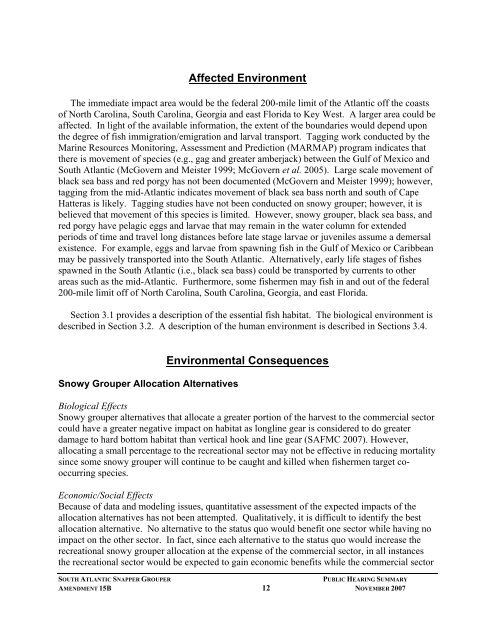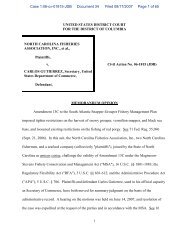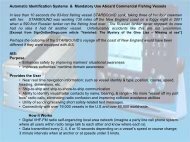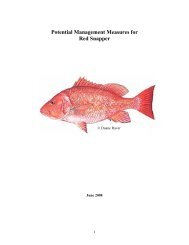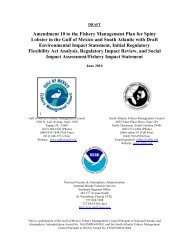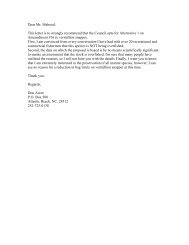SNAPPER GROUPER AMENDMENT 15B - SAFMC.net
SNAPPER GROUPER AMENDMENT 15B - SAFMC.net
SNAPPER GROUPER AMENDMENT 15B - SAFMC.net
- No tags were found...
Create successful ePaper yourself
Turn your PDF publications into a flip-book with our unique Google optimized e-Paper software.
Affected EnvironmentThe immediate impact area would be the federal 200-mile limit of the Atlantic off the coastsof North Carolina, South Carolina, Georgia and east Florida to Key West. A larger area could beaffected. In light of the available information, the extent of the boundaries would depend uponthe degree of fish immigration/emigration and larval transport. Tagging work conducted by theMarine Resources Monitoring, Assessment and Prediction (MARMAP) program indicates thatthere is movement of species (e.g., gag and greater amberjack) between the Gulf of Mexico andSouth Atlantic (McGovern and Meister 1999; McGovern et al. 2005). Large scale movement ofblack sea bass and red porgy has not been documented (McGovern and Meister 1999); however,tagging from the mid-Atlantic indicates movement of black sea bass north and south of CapeHatteras is likely. Tagging studies have not been conducted on snowy grouper; however, it isbelieved that movement of this species is limited. However, snowy grouper, black sea bass, andred porgy have pelagic eggs and larvae that may remain in the water column for extendedperiods of time and travel long distances before late stage larvae or juveniles assume a demersalexistence. For example, eggs and larvae from spawning fish in the Gulf of Mexico or Caribbeanmay be passively transported into the South Atlantic. Alternatively, early life stages of fishesspawned in the South Atlantic (i.e., black sea bass) could be transported by currents to otherareas such as the mid-Atlantic. Furthermore, some fishermen may fish in and out of the federal200-mile limit off of North Carolina, South Carolina, Georgia, and east Florida.Section 3.1 provides a description of the essential fish habitat. The biological environment isdescribed in Section 3.2. A description of the human environment is described in Sections 3.4.Snowy Grouper Allocation AlternativesEnvironmental ConsequencesBiological EffectsSnowy grouper alternatives that allocate a greater portion of the harvest to the commercial sectorcould have a greater negative impact on habitat as longline gear is considered to do greaterdamage to hard bottom habitat than vertical hook and line gear (<strong>SAFMC</strong> 2007). However,allocating a small percentage to the recreational sector may not be effective in reducing mortalitysince some snowy grouper will continue to be caught and killed when fishermen target cooccurringspecies.Economic/Social EffectsBecause of data and modeling issues, quantitative assessment of the expected impacts of theallocation alternatives has not been attempted. Qualitatively, it is difficult to identify the bestallocation alternative. No alternative to the status quo would benefit one sector while having noimpact on the other sector. In fact, since each alternative to the status quo would increase therecreational snowy grouper allocation at the expense of the commercial sector, in all instancesthe recreational sector would be expected to gain economic benefits while the commercial sectorSOUTH ATLANTIC <strong>SNAPPER</strong> <strong>GROUPER</strong>PUBLIC HEARING SUMMARY<strong>AMENDMENT</strong> <strong>15B</strong> 12 NOVEMBER 2007


